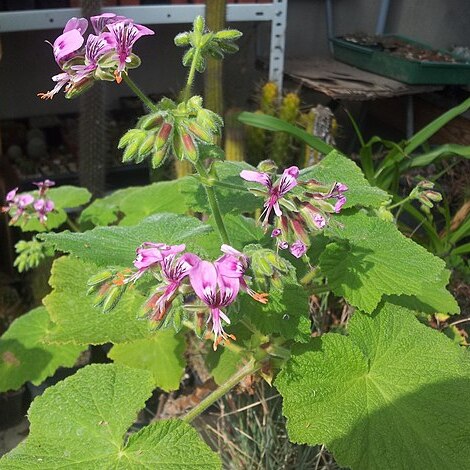Erect, much-branched, strongly aromatic shrub with an unpleasant odour, up to 2.5 m high and 1.5 m in diameter. Stems herbaceous when young but soon becoming woody, villous and with glandular hairs interspersed, green but becoming greyish-brown with age. Leaves sparsely villous and densely interspersed with glandular hairs, green; lamina cordiform in outline, shallowly 3-(5-8)-lobed, conspicuously veined, base cordate, apices of lobes usually obtuse but sometimes acute, margin crenate-dentate, (25-)85(-190) x (25-)100(-250) mm; petiole (10-)50-70(-250) mm long; stipules cordiform to triangular, 4-10 x 3-12 mm. Inflorescence: flowering branches profusely branched, with smaller foliar leaves, peduncles 20-100 mm long, villous and with glandular hairs interspersed; involucral bracts ovate, apiculate, indumentum as on peduncles, 5-8 x 4-6 mm; pseudo-umbels with 4-20 flowers each. Pedicel 7-15 mm long, relatively thin, sparsely villous and densely interspersed with glandular hairs. Hypanthium 2-5 mm long, prominently thickened at the base. Sepals lanceolate, apiculate, indumentum abaxially as on pedicel, green with a reddish-brown tint, ±8 x 3-4 mm. Petals pale pink to carmine; posterior two spathulate to obovate, apices obtuse to emarginate, with a dark red-purplish and white blotch, reflexed at more than 90°, ±20 x 7 mm; anterior three narrowly spathulate with short claws, reflexed at less than 90°, ±7 x 2 mm. P. papilionaceum flowers from August to January with a peak in September-October. Except for the mid-winter months, the odd flower can be found throughout the year.
More
Foetid shrub to 1 m. Leaves cordate with margins very shallowly lobed, 8 cm or more diam. Flowers to 20 on branching peduncles at branch tips, ± 30 mm diam., pink with conspicuous darker markings on much larger upper petals; hypanthium 2-5 mm long, much shorter than pedicel.

